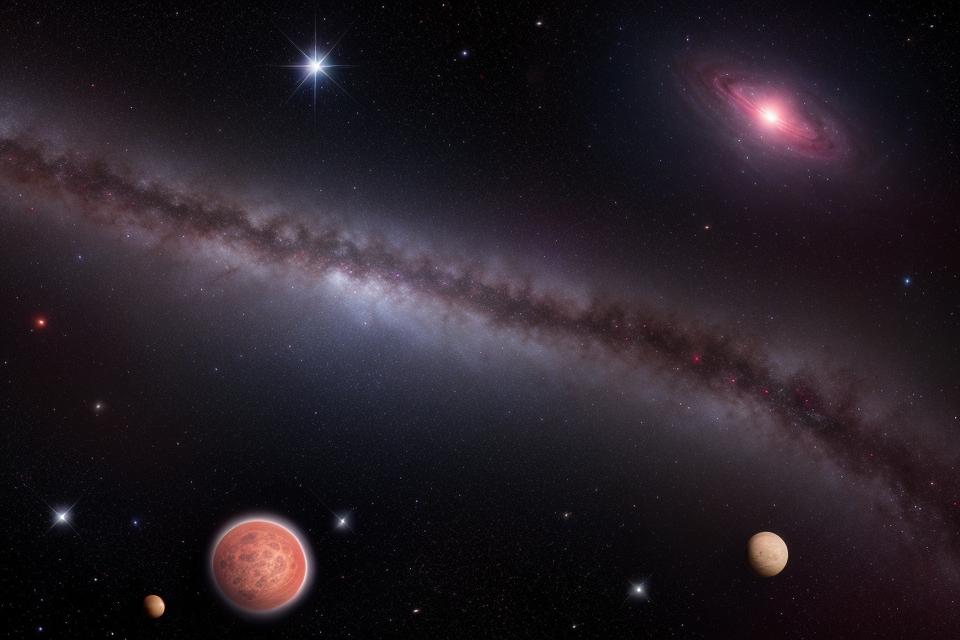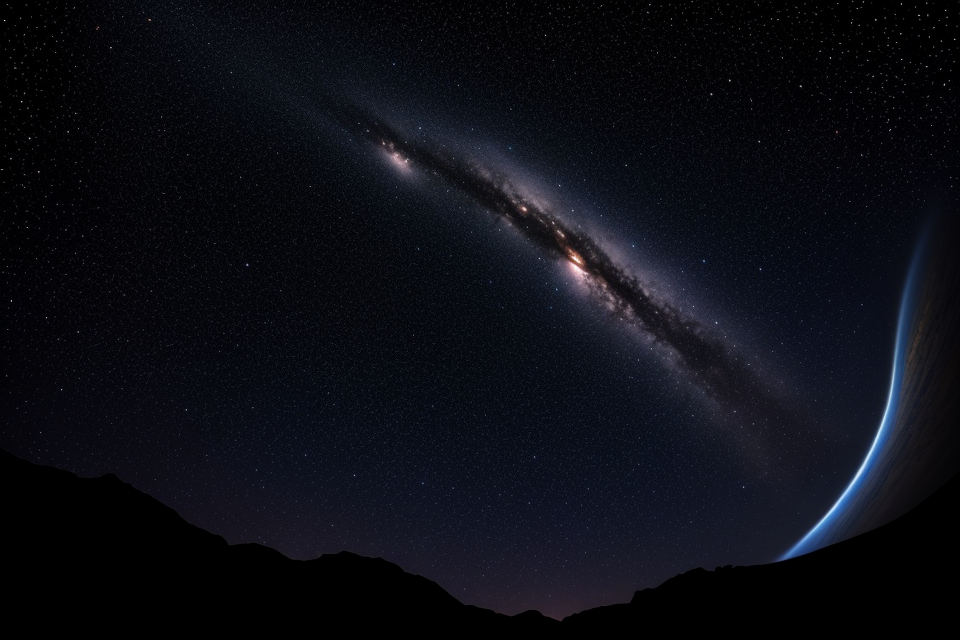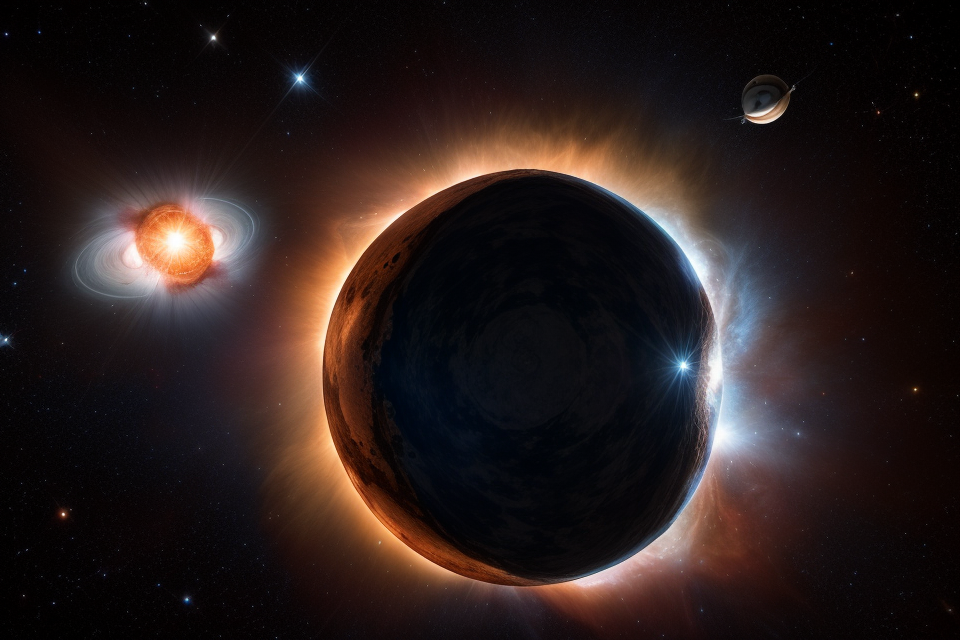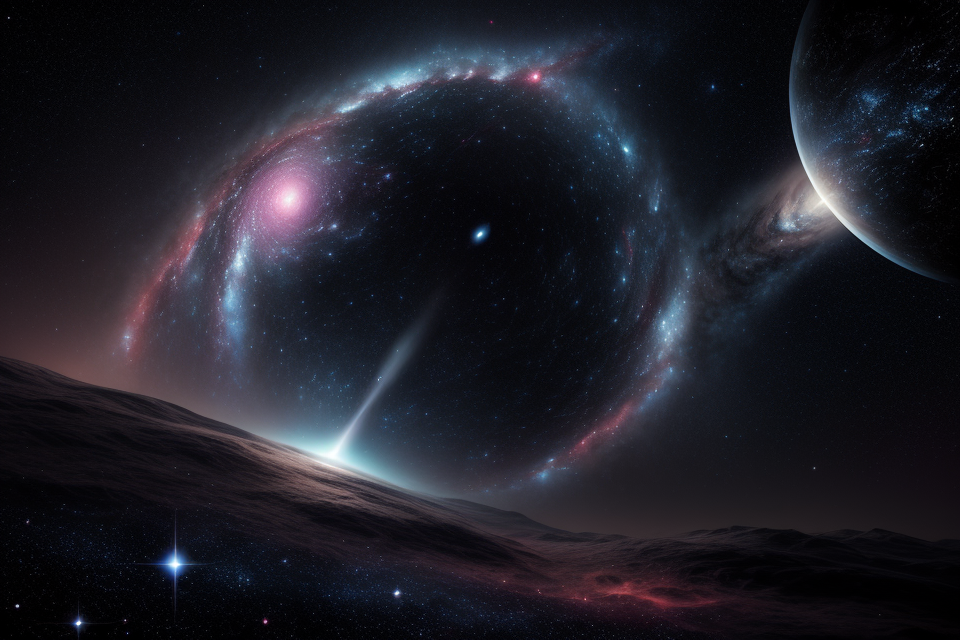Celestial objects are fascinating entities that exist in the vast expanse of our universe. These objects can range from planets, stars, galaxies, and even black holes. Understanding celestial objects is crucial for comprehending the workings of our universe and the many wonders it holds. In this overview, we will explore some examples of celestial objects and learn about their unique characteristics and properties. From the blistering heat of stars to the mysterious gravitational pull of black holes, the world of celestial objects is an awe-inspiring and mind-boggling one that is waiting to be explored.
What are Celestial Objects?
Types of Celestial Objects
Stars
Stars are massive, luminous celestial bodies that emit light and heat through nuclear reactions occurring in their cores. They are classified based on their temperature, color, and size, with the Sun being a typical G-type main-sequence star. Other types include red giants, white dwarfs, and neutron stars.
Planets
Planets are celestial bodies that orbit a star, are spherical in shape, and have cleared their orbits of other debris. In our solar system, there are eight planets: Mercury, Venus, Earth, Mars, Jupiter, Saturn, Uranus, and Neptune. Each planet has unique characteristics, such as Earth’s ability to support life and Jupiter’s powerful magnetic field.
Moons
Moons are natural satellites that orbit planets or dwarf planets. They are formed from the debris left over from the formation of the planet they orbit. Our solar system has numerous moons, including Earth’s Moon, Mars’ Phobos and Deimos, Jupiter’s Galilean moons (Io, Europa, Ganymede, and Callisto), and Saturn’s moons Titan and Enceladus.
Comets
Comets are icy bodies composed of dust, ice, and other volatile compounds. When heated by the Sun, these compounds vaporize, creating a bright, long-lasting tail. Comets orbit the Sun and can be found throughout the solar system. They are typically classified based on their orbital characteristics and brightness.
Asteroids
Asteroids are rocky bodies that orbit the Sun and are often found in the asteroid belt between Mars and Jupiter. They range in size from small boulders to objects hundreds of miles across. Some asteroids, like 16 Psyche, are thought to be composed primarily of metal and could potentially be mined for valuable resources.
Nebulae
Nebulae are clouds of gas and dust that form when stars are born and die. They can be found throughout the universe and come in various shapes and sizes. Some nebulae, like the Orion Nebula, are bright and colorful, while others, like the Horsehead Nebula, are dark and mysterious. Nebulae play a crucial role in the evolution of the universe and are often studied to better understand the life cycle of stars.
How are Celestial Objects Formed?
The Life Cycle of a Star
The life cycle of a star begins with its formation from a cloud of gas and dust, which collapses under its own gravity. As the cloud collapses, it becomes denser and hotter, eventually reaching temperatures and pressures high enough for nuclear fusion to begin. This process, known as nucleosynthesis, creates lighter elements such as helium and hydrogen from heavier elements such as carbon and oxygen.
Once nucleosynthesis has begun, the star enters a period of stable fusion, during which it converts hydrogen into helium and releases a tremendous amount of energy in the form of light and heat. This energy causes the star to expand and cool, and it becomes a main-sequence star.
As a star ages, it continues to fuse hydrogen into helium in its core, but eventually, the hydrogen fuel runs out and the star begins to contract. This causes an increase in temperature and pressure, leading to the formation of a new, hotter core made of helium. This new core ignites and begins to fuse helium into carbon and oxygen, creating an even hotter and more luminous star.
Eventually, the star’s fuel runs out completely, and it can no longer support itself against its own gravity. It collapses in on itself, causing a massive release of energy in the form of a supernova explosion. This explosion blasts the star’s outer layers into space, leaving behind a dense, compact object such as a neutron star or black hole.
The life cycle of a star is a complex and dynamic process that shapes the universe around us, from the formation of new stars to the explosive deaths of old ones. Understanding this process is key to understanding the evolution of our universe and the role that stars play in it.
The Formation of Planets
The formation of planets is a fascinating process that has been studied extensively by astronomers and astrophysicists. According to the Nebular Hypothesis, the solar system began as a cloud of gas and dust, which collapsed under its own gravity to form a protostar at the center. As the material around the protostar continued to collapse, it began to rotate faster and faster, forming a flattened disk of material known as an accretion disk.
This accretion disk was composed of a variety of elements, including hydrogen, helium, and heavier elements like iron and silicon. Over time, the material in the accretion disk began to condense and form larger and larger bodies, eventually leading to the formation of the planets we see today.
The process of planet formation is thought to involve several stages. First, small particles and dust grains begin to stick together, forming larger and larger bodies. As these bodies grow, they begin to attract more and more material, eventually forming protoplanets. These protoplanets continue to grow until they eventually become fully-formed planets, complete with a core, mantle, and crust.
The final size and composition of a planet depends on a variety of factors, including the amount of material available in the accretion disk and the speed at which it is collapsing. For example, Jupiter is thought to have formed much more quickly than Earth, leading to its massive size and powerful magnetic field.
Overall, the formation of planets is a complex and ongoing process that continues to captivate scientists and laypeople alike. By studying the formation of our own solar system, we can gain valuable insights into the universe as a whole and the many celestial objects that populate it.
Observing Celestial Objects
Telescopes
Refracting Telescope
A refracting telescope uses a lens to gather and magnify light from celestial objects. It is one of the oldest types of telescopes and works based on the principle of refraction. The lens in a refracting telescope can be made of glass or other transparent materials and is usually curved. This curvature of the lens causes light rays to bend and pass through the lens, which results in magnification and enhances the detail of the celestial object being observed.
Reflecting Telescope
A reflecting telescope uses a mirror to gather and focus light from celestial objects. It works based on the principle of reflection and is one of the most common types of telescopes used today. The primary mirror in a reflecting telescope is usually made of glass and is curved to reflect light. The mirror gathers light from the celestial object and directs it towards a secondary mirror, which then focuses the light towards the eyepiece. This design allows for a much larger mirror, which results in a larger and more detailed image of the celestial object being observed.
Radio Telescope
A radio telescope is a type of telescope that uses radio waves to observe celestial objects. Radio telescopes are designed to detect and observe objects that emit radio waves, such as stars, galaxies, and other celestial objects. These telescopes work by using a large dish-shaped antenna to collect radio waves from the celestial object being observed. The radio waves are then amplified and processed to produce an image of the object. Radio telescopes are useful for studying objects that are too distant or too faint to be studied using other types of telescopes.
Astronomical Observatories
Astronomical observatories are specialized facilities designed for the study of celestial objects. They play a crucial role in advancing our understanding of the universe by providing a means to gather data on the physical properties and behavior of celestial objects. There are two main types of astronomical observatories: space telescopes and ground-based observatories.
Space Telescopes
Space telescopes are observatories located in space, designed to observe celestial objects from a vantage point outside the Earth’s atmosphere. They offer several advantages over ground-based observatories, including the ability to observe objects in the infrared and ultraviolet regions of the electromagnetic spectrum, which are blocked by the Earth’s atmosphere. Additionally, space telescopes can observe objects for longer periods without interruption from clouds or atmospheric phenomena.
Some notable space telescopes include the Hubble Space Telescope, the Chandra X-ray Observatory, and the Spitzer Space Telescope. These telescopes have provided valuable insights into the formation and evolution of galaxies, the nature of dark matter, and the search for exoplanets, among other discoveries.
Ground-based Observatories
Ground-based observatories are located on Earth and rely on sophisticated telescopes and instruments to observe celestial objects. These observatories offer several advantages, including their ability to observe objects in visible light with high spatial resolution and to observe a wide range of wavelengths, including radio and submillimeter waves.
Some notable ground-based observatories include the Mauna Kea Observatory in Hawaii, the Very Large Telescope (VLT) in Chile, and the Green Bank Observatory in West Virginia. These observatories have made significant contributions to our understanding of the universe, including the discovery of exoplanets, the study of stellar evolution, and the detection of gravitational waves.
In conclusion, astronomical observatories play a crucial role in advancing our understanding of the universe. By providing a means to gather data on the physical properties and behavior of celestial objects, these observatories have enabled us to make significant discoveries about the nature of the universe and our place within it.
Celestial Objects and Human Exploration
Space Exploration
- The First Manned Mission to Space
- On April 12, 1961, Soviet cosmonaut Yuri Gagarin became the first human to travel into space aboard the Vostok 1 spacecraft.
- The mission lasted approximately 108 minutes, and Gagarin orbited the Earth once during his historic flight.
- This achievement marked a significant milestone in the Space Race between the United States and the Soviet Union.
- The Moon Landing
- On July 20, 1969, NASA’s Apollo 11 mission successfully landed astronauts Neil Armstrong and Edwin “Buzz” Aldrin on the surface of the Moon.
- Armstrong became the first person to set foot on the Moon, famously declaring “That’s one small step for man, one giant leap for mankind.”
- The Moon landing was the culmination of years of intense effort and technological innovation by NASA and its partners.
- Future Space Exploration Plans
- In the coming years, NASA and other space agencies have ambitious plans for exploring our solar system and beyond.
- These include missions to Mars, Saturn’s moon Titan, and even a potential manned mission to Venus.
- Advancements in technology and new discoveries about celestial objects are making these missions more feasible than ever before.
- However, these missions also present significant challenges and risks, requiring continued innovation and collaboration among scientists and engineers.
The Impact of Celestial Objects on Earth
Throughout history, celestial objects have had a profound impact on Earth, shaping its landscape and altering the course of life. Among these objects, meteor impacts, asteroid impacts, and comet impacts have been particularly influential.
- Meteor Impacts
Meteors, also known as shooting stars, are small rocky or metallic objects that originate from asteroids or comets. When they enter Earth’s atmosphere, they are heated to extreme temperatures and can create a brilliant light in the sky. While most meteors burn up before reaching the ground, some do manage to survive and land on Earth’s surface.
Meteor impacts have been responsible for some of the most significant events in Earth’s history. For instance, the massive impact of a meteor caused the extinction of the dinosaurs around 65 million years ago. This catastrophic event created a crater over 100 miles in diameter, known as the Chicxulub Crater, located off the coast of Mexico’s Yucatan Peninsula.
- Asteroid Impacts
Asteroids are larger than meteors and are typically found in the asteroid belt between Mars and Jupiter. They can vary in size from small rocks to massive bodies several miles in diameter. While most asteroids pose no threat to Earth, some have the potential to collide with our planet.
In 1908, a massive asteroid exploded over Tunguska, Siberia, flattening an estimated 80 million trees over an area of 2,000 square miles. The impact created a shockwave that was felt hundreds of miles away, and the event remains one of the most significant asteroid impacts in Earth’s history.
- Comet Impacts
Comets are icy bodies composed of rock, ice, and dust that orbit the Sun. When they approach the Sun, they vaporize, creating a spectacular display of gas and dust known as a comet tail. Some comets have been known to impact Earth, often with devastating consequences.
One of the most famous comet impacts occurred in 1908, when a comet collided with the city of Tunguska, Russia. The impact caused a massive explosion, flattening an estimated 80 million trees over an area of 2,000 square miles. The event remains one of the most significant comet impacts in Earth’s history.
In conclusion, celestial objects have had a profound impact on Earth throughout history. From meteor impacts to asteroid and comet impacts, these events have shaped our planet’s landscape and altered the course of life. Understanding the nature of these impacts is crucial for mitigating their potential effects on our planet and safeguarding humanity’s future.
The Enduring Fascination with Celestial Objects
- Cultural Significance
- The role of celestial objects in human culture throughout history
- Constellations and their significance in navigation and storytelling
- The impact of celestial events, such as eclipses and comets, on ancient civilizations
- The influence of celestial objects on human imagination and creativity
- Mythology and folklore inspired by the night sky
- Literary works that reference celestial objects and phenomena
- The role of celestial objects in human culture throughout history
- Scientific Significance
- The importance of celestial objects in advancing scientific knowledge
- The study of celestial objects for understanding the universe and our place in it
- The use of celestial objects for navigation and the development of astronomy
- The impact of telescopes and other technological advancements on our understanding of celestial objects
- Revealing the secrets of distant worlds and the evolution of stars and galaxies
- Advances in space exploration and the search for extraterrestrial life
- The importance of celestial objects in advancing scientific knowledge
- Future Exploration and Discovery
- The potential for continued human exploration and discovery of celestial objects
- Space missions to study celestial objects and the search for habitable worlds
- Advancements in propulsion technology and the possibility of interstellar travel
- The ethical considerations and challenges of exploring and exploiting celestial resources
- The responsibilities of nations and corporations in the exploration and utilization of celestial objects
- The potential for conflict and cooperation in the exploitation of resources in space
- The potential for continued human exploration and discovery of celestial objects
FAQs
1. What is a celestial object?
A celestial object is any natural object that exists in the sky or outer space. This includes stars, planets, moons, comets, asteroids, nebulas, and galaxies.
2. How many celestial objects are there in the universe?
It is difficult to determine the exact number of celestial objects in the universe, as new ones are constantly being discovered. However, it is estimated that there are billions of stars in our galaxy alone, and billions of galaxies in the observable universe.
3. What is the difference between a star and a planet?
A star is a massive, luminous ball of gas that emits light and heat through nuclear reactions in its core. A planet is a celestial body that orbits a star, is spherical in shape, and has cleared its orbit of other debris.
4. Can I see celestial objects with my own eyes?
Yes, many celestial objects are visible to the naked eye, such as the Sun, Moon, and stars. With the use of a telescope or binoculars, you can also observe more distant objects such as planets, moons, and galaxies.
5. What is the most distant celestial object that can be studied in detail?
The most distant celestial object that can be studied in detail is the galaxy UDFj-39546284, which is located 13.2 billion light-years away from Earth. This galaxy is so far away that its light has taken over 13 billion years to reach us, making it one of the most distant objects that can be studied in detail.



